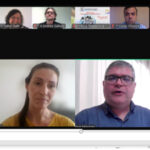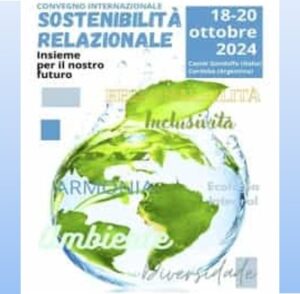Togetherness a global event that considers communication in the service of peace and unity.
How can communication promote peace? What does it mean to use media as a tool to build bridges between different cultures and communities? These are the questions at the heart of “Togetherness: Communication & Media for Peace,” the international seminar organized by NetOne and dedicated to exploring the key role of communication in building a more just, united and peaceful society. This on-line event was held between Nov. 8 and 9, 2024 from 2 p.m. to 5:30 p.m. (Rome time). A unique opportunity for all those who wish to understand and practice effective communication strategies in the service of the common good. You will soon be able to follow it on NetOne’s YouTube channel.
 Una comunicazione che unisce
Una comunicazione che unisce
Communication that unites
In an era characterized by global divisions and tensions, the ability to communicate empathetically and constructively has become an essential skill.
The choice of the theme “Togetherness” is not accidental: the aim of the conference was precisely to explore the concept of unity, fraternity and solidarity through communication, to provide participants with concrete elements, case studies and success stories to inspire and motivate them to use communication as a lever for social change.
In fact, the seminar brought together leading figures in the field: international communicators, journalists, educators, intercultural relations scholars and representatives of global organizations to reflect and discuss on how media and communication can become tools to break down barriers, overcome prejudices and foster intercultural dialogue, and promote peace.
In her opening remarks, Isabel Gatti, NetOne International Coordinator, expressed the meaning of this meeting, “Togetherness,, never war again. To be together, to be in unity, fraternity, peace; this is the cry that emerges from the heart of our NetOne Community. Today we convene to speak our words, which from different continents want to unite to build another communication. A “New Communication,” as Chiara Lubich invited us to promote in the founding days of NetOne. With it we want to embrace the pain of this humanity that, as at the dawn of the Focolare Movement, experiences the fragmentation of the human community because of armed conflicts.”
 The program consisted of two intense and jam-packed days of talks, ranging from hot topics such as the role of social media in countering misinformation and hate speech to exploring the potential of community and participatory communication. Each talk is designed to offer food for thought but also concrete examples and strategies applicable in each participant’s professional and personal life.
The program consisted of two intense and jam-packed days of talks, ranging from hot topics such as the role of social media in countering misinformation and hate speech to exploring the potential of community and participatory communication. Each talk is designed to offer food for thought but also concrete examples and strategies applicable in each participant’s professional and personal life.
One of the most innovative aspects of Togetherness is the interactive dimension of the event, designed to encourage direct discussion among participants and create a space where everyone can share their experiences and expertise. This structure facilitates the creation of an international network of professionals and enthusiasts who share the same vision of communication in the service of peace.
The seminar also represented a unique opportunity for networking and forging high-level professional relationships. This event allowed us to expand our network of contacts and gain a global perspective on communication for peace.
A distinctive element of Togetherness is its official flyer, created by FM Communication of Francesco Mazzarella. This flyer is not only a promotional tool, but a true visual vehicle of the seminar’s mission.
The conclusions, prepared by Laura Gherlone, express the quality of what has been lived;
We have come to the end of our International Congress “Togetherness: Communication & Media for Peace.” When we started thinking about the title of this event, we came up with a space for meeting and coming together to help each other believe and generate peace: hence the word togetherness. Today this term is used insistently in media studies to express that particular phenomenon that the Internet has produced, namely the possibility of being together and feeling close, almost epidermically, despite different geographies and longitudes. However, we reflected over these two days that this proximity or “being together” is not always qualitatively high and relationally fruitful in terms of interpersonal relationships In all the spaces of reflection we shared between yesterday and today, from digital ethics to generative communication, from edu-communication to dialogical journalism, the need to re-interrogate ourselves on the “life world” in this post-medial universe in which we are immersed came up. Especially in the working-groups, a desire arose to work together on new models of education and media literacy and especially data literacy; to reflect together on the world of computer ethics and AI, both at the theoretical level as well as at the level of protocols and best practices; to come together to promote a culture of solidarity and reconciliation precisely through the tools that the media ecosystem offers us, as influencers for peace do; to draw back to the figure of Chiara Lubich and the Charism of Unity to face together the challenges of a global reality that, as various contributors pointed out, is complex and deeply polarized.
The 25th anniversary of the founding of NetOne seems to us an excellent opportunity to team-up and make visible the working network of research and good practices that we are all already pursuing. As Pope Francis says, “in the adventure of life we are not alone, Jesus extends his hand to us.” In this perspective, working in the world of Communication, with a capital C, and especially doing it together, really means working for a medium of hope: a way to dilute loneliness, qualitatively increase “being together” and be generators of relational goods and peace.
 In conclusion, we thank each and every one for participating. We especially thank Francesco Mazzarella who made possible all the organization and technical implementation of the meeting and the translators who accompanied us, making it possible to express ourselves in our plurality of languages.
In conclusion, we thank each and every one for participating. We especially thank Francesco Mazzarella who made possible all the organization and technical implementation of the meeting and the translators who accompanied us, making it possible to express ourselves in our plurality of languages.
Finally, we would like to remind you that we would like to make available the contributions presented at this Congress that the open perspectives may be accessible to all in the form of working and reflective materials, representing hopefully a starting point for further research. Presenters will be invited to expand the abstracts in the form of an article for open-access digital publication.
Laura Gherlone e Frascesco Mazzarella








